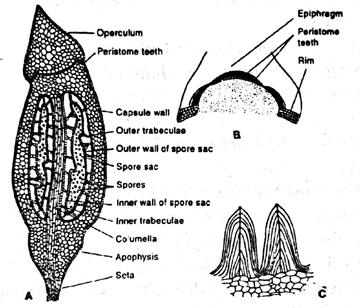Describe the structure of sporophyte of Polytrichum.
Q. Describe the structure of sporophyte of Polytrichum.
Ans. In case of polytrichum, the sporophyte consists of a foot, a long seta and a capsule.
The foot, a zone of thin-walled parenchymatous cells, is prolonged in the apical tissue of the female plant.

Fig. Polytrichum sp. A- L. S. of capsule; B- structure of operculum and C – peristome teeth
The seta lies just above the foot and is a slender long structure made up of tissue with well marked differentiation. A superficial layer has thick-walled cells. It is followed by a band of sclerenchymatous cells that merges with the underlying thin-walled chlorophyll containing parenchymatous cells with intercellular spaces. The central strand lacks intercellular spaces and the cells constituting it are essentially similar but simpler to those occurring in the axis of the aerial leafy shoot. It helps in supporting as well as in bringing the capsule at a desired level. At the base of the capsule the seta enlarges and forms the apophysis with well marked epidermis possessing stomata. The stomata slightly project above the level of the epidermis and are nonfunctional and usually occur in the furrows.
The capsule is differentiated into three distinct zones: (i) a prominent
apophysis, (ii) a spore bearing zone, the theca and (iii) an operculum.
The apophysis has three or four layers of cells: thick-walled epidermis, chlorophyllous tissue with prominent intercellular spaces and a central axis which is continuous with the columella above and the central cylinder of seta below. A distinct groove occupied by the stomata occurs in between the apophysis theca.
The theca in its middle part exhibits distinct ridges giving it a polygonal appearance. The wall is composed of several layers of chlorophyllose cells. The outermost layer of the wall is differentiated into an epidermis, of which the cells possess thickened outer wall.
An outer lacuna (air space) traversed by radially elongated filaments of chlorophyllose cells occurs inner to the wall. One end of these filaments is connected with the inner layer of the wall whereas the other with the outer wall of the spore sac. Internally the spore sac is bounded by the inner lacuna, the filaments of which connect the spore sac with the centrally placed columella.
The spore sac, on both outer and inner side, is bounded by two layers of thin-walled cells. The archesporium may be one or more layers of cells thick. The thickness depends on the age of the sporogonium. All its sporogenous cells get transformed into the spores.
The columella, the sterile central tissue, consists of a column of thin walled cells continuous with the epiphragm above and with the central axis of the apophysis below.
The operculum, an uppermost part of the capsule, lies above the theca from which it is restricted by thickened diaphragm (rim). The operculum with prominent beak-like projection, the rostrum looks like a conical lid. A transverse band of thin membranous tissue composed of pale compressed cells without intercellular spaces forms the epiphragm. This disc-shaped epiphragm stretches like a drum head (tympanum) over the opening of the capsule and closes it.
The peristome consists of 32 or 64 short pyramidal teeth that are connected below with the wall of the capsule. The apices of the peristomial teeth are united with the margin of the epiphragm through which come out the spores by swaying of the capsule in air which causes a gradual spore dispersal.
The spore: The spores are yellow and remain viable for a pretty long time. They are very small ranging from 0.005-0.01 mm. in diameter.

Fig. Polytrichum sp. (A to E-stages in the germination of spore and F-an enlarged bud)
The spores absorb water, swell and become green due to the development of the chloroplasts. The exospore ruptures at one or several points giving out one or more germ tubes. Germ tubes elongate and develop several septae to become filamentous protonema. Some of the filaments become attached to the substratum or penetrate below and remain colourless and form rhizoids. A number of filaments turn upright and become green. Very soon the buds are developed at the base of the upright green filaments from which develop aerial leafy shoots (gametophores) by the activity of the apical cell.
Follow on Facebook page – Click Here
Google News join in – Click Here
Read More Asia News – Click Here
Read More Sports News – Click Here
Read More Crypto News – Click Here